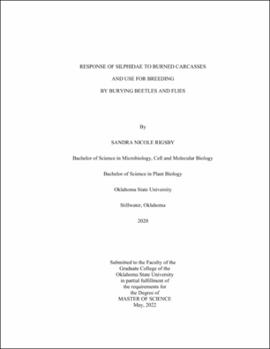| dc.description.abstract | When an animal dies, the resources in its body are used by a range of organisms including bacteria, fungi, invertebrate and vertebrate necrophores. Among these organisms, burying beetles in the Genus Nicrophorus are specialized to detect the carcass soon after death, bury it if it is an appropriate size, and use biparental care to rear offspring in an underground brood chamber. Many factors can cause the death of an animal, including wildfires and prescribed burns, but the effects of burned bodies on response and utilization of insect necrophores, including burying beetles has been poorly studied. Self-sustaining populations of the threatened Nicrophorus americanus occur at Camp Gruber, a military training facility and wildlife management area, near Braggs, OK. Because of training activities and planned prescribed burns to manage vegetation, studies were conducted to understand how Nicrophorus species respond to fire and whether burned carrion would be used as a food and or reproductive source. Three separate five-day sampling studies were conducted from May to July. Hanging pitfall traps were baited with either unburned, slightly burned, moderately burned, or severely burned rat carcasses. All carrion beetles were identified and counted. In the laboratory, reproduction on burned mice was tested along with survival of beetles buried in soil that had a fire burn above it. Nicrophorus, including American burying beetles, used burned carcasses for food and reproduction was similar on slightly burned carcasses as unburned controls. Additionally, in a lab experiment house flies had higher reproductive succcess on moderate and severely burned carcasses, although differences were not statistically significant. Because burying beetles survived beneath the surface, and were capable of utilizing burned carcasses, prescribed fire is unlikely to harm American burying beetles, and potentially can benefit them. Flies can also use burned carcasses for reproduction and populations of flies and beetles should be monitored after wild fires and prescribed burns. | |
